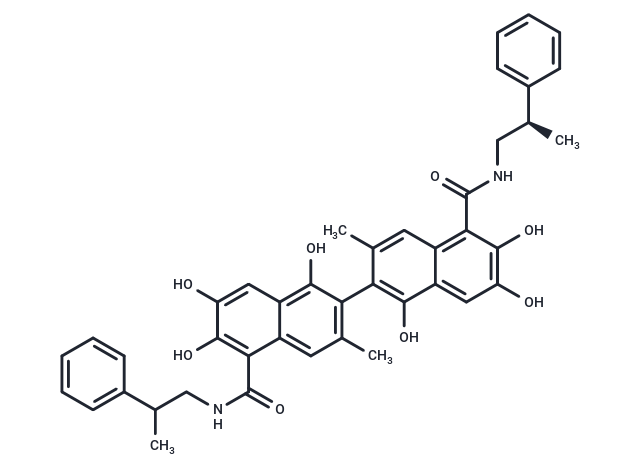Shopping Cart
- Remove All
 Your shopping cart is currently empty
Your shopping cart is currently empty

Sabutoclax (BI-97C1)(BI-97C1) is a pan-Bcl-2 inhibitor, including Bcl-xL, Bcl-2, Mcl-1 and Bfl-1 with IC50 of 0.31 μM, 0.32 μM, 0.20 μM and 0.62 μM, respectively.

| Pack Size | Price | Availability | Quantity |
|---|---|---|---|
| 1 mg | 60 € | In Stock | |
| 5 mg | 147 € | In Stock | |
| 10 mg | 234 € | In Stock | |
| 25 mg | 472 € | In Stock | |
| 50 mg | 748 € | In Stock | |
| 100 mg | 1.016 € | In Stock | |
| 1 mL x 10 mM (in DMSO) | 160 € | In Stock |
| Description | Sabutoclax (BI-97C1)(BI-97C1) is a pan-Bcl-2 inhibitor, including Bcl-xL, Bcl-2, Mcl-1 and Bfl-1 with IC50 of 0.31 μM, 0.32 μM, 0.20 μM and 0.62 μM, respectively. |
| Targets&IC50 | Bfl-1:0.62 μM, MCL1:0.2 μM, BCL2:0.32 μM, BCL-XL:0.31 μM |
| In vitro | Sabutoclax (0.001-10 μM; 72 hours) inhibits the growth of human prostate cancer and lung cancer cell lines[2]. Sabutoclax (0.01-1 μM; 24-48 hours) induces apoptosis in human diffuse large B-cell lymphoma cells[2]. Sabutoclax (0-15 μM; 48 hours) upregulates the levels of pro-apoptotic proteins in chemotherapy-resistant cells[1]. |
| In vivo | Sabutoclax (1-5 mg/kg; intraperitoneal injection; every two days for a total of 18 days) reduces the growth of M2182 tumors in nude mice[2]. |
| Kinase Assay | Competitive fluorescence polarization assays (FPA) : A Bak BH3 peptide (F-BakBH3) (GQVGRQLAIIGDDINR) is labeled at the N-terminus with fluorescein isothiocyanate (FITC) and purified by HPLC. For competitive binding assays, 100 nM GST-Bcl-XL ΔTM protein is preincubated with the tested compound at varying concentrations in 47.5 μL PBS (pH = 7.4) in 96-well black plates at room temperature for 10 min, and then 2.5 μL of 100 nM FITC-labeled Bak BH3 peptide is added to produce a final volume of 50 μL. The wild-type and mutant Bak BH3 peptides are included in each assay plate as positive and negative controls, respectively. After 30 min incubation at room temperature, the polarization values in millipolarization units are measured at excitation/emission wavelengths of 480/535 nm with a multilabel plate reader. IC50 is determined by fitting the experimental data to a sigmoidal dose-response nonlinear regression model. Data reported are mean of three independent experiments. Performance of Bcl-2 and Mcl-1FPA are similar. Briefly, 50 nM of GST-Bcl-2 or -Mcl-1are incubatedwith various concentrations of compound (4 and 11-14) for 2 min, and then 15 nM FITC-conjugated-Bim BH3 peptide is added in PBS buffer. Fluorescence polarization is measured after 10 min. |
| Cell Research | ATP-LITE assay(Only for Reference) |
| Alias | BI-97C1 |
| Molecular Weight | 700.78 |
| Formula | C42H40N2O8 |
| Cas No. | 1228108-65-3 |
| Smiles | CC(CNC(=O)c1c(O)c(O)cc2c(O)c(c(C)cc12)-c1c(C)cc2c(C(=O)NC[C@H](C)c3ccccc3)c(O)c(O)cc2c1O)c1ccccc1 |
| Relative Density. | 1.358 g/cm3 (Predicted) |
| Storage | store at low temperature | Powder: -20°C for 3 years | In solvent: -80°C for 1 year | Shipping with blue ice. | ||||||||||||||||||||||||||||||||||||||||
| Solubility Information | H2O: < 1 mg/mL (insoluble or slightly soluble) Ethanol: 22 mg/mL (31.4 mM) DMSO: 93 mg/mL (132.7 mM) | ||||||||||||||||||||||||||||||||||||||||
Solution Preparation Table | |||||||||||||||||||||||||||||||||||||||||
Ethanol/DMSO
DMSO
| |||||||||||||||||||||||||||||||||||||||||

Copyright © 2015-2024 TargetMol Chemicals Inc. All Rights Reserved.